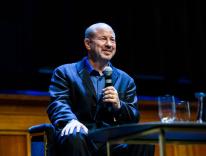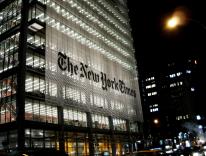These days the news business appears to be teetering precariously between extinction and a banal ubiquity. On the one hand, each day seems to usher in more crises for newspapers, the traditional bastion of serious, for-the-record daily enlightenment. Beset by plummeting advertising and sinking circulation, the medium is declining before our eyes. Recently, the Tribune Corporation (parent of the Los Angeles Times, the Baltimore Sun, and other esteemed dailies) declared bankruptcy, while no less an icon than the New York Times began selling front-page display ads.
At the same time, electronic outlets (blogs, CNN and other news-channel sites, the miniheadlines that may ornament your browser’s homepage) are so omnipresent and constant, and sometimes so trivial, that they have become little more than background noise. Too much news is sometimes no news at all, as various election nonstories made clear.
Anchoring itself boldly between these two extremes is the Newseum, a 250,000-sq.-ft. homage to journalism that, after a previous incarnation in Arlington, Virginia, opened in Washington, D.C., last April to considerable fanfare. Located near the National Mall, the complex of multimedia exhibit halls and theaters bills itself as the “world’s most interactive museum,” a claim it backs up with ample user-friendly technology, such as studios that allow you to film yourself acting as a TV news anchor.
But what’s most striking about the Newseum—which will offer several blissful hours of educational diversion to anyone willing to shell out up to $20 for a ticket—is not its hands-on functionality but its philosophical intensity. Each sleekly designed display case, each strategically selected portion of historical footage flickering on a screen, preaches about journalism’s practical effectiveness and existential significance-hardly surprising, given that founding partners include the New York Times Company, the News Corporation, and other media-mogul entities.
A room on the top floor exemplifies the gestalt: inside a glass display box, a time line chronicles the history of reportage, starting with the invention of language (c. 100,000 BC). Inscribed in white letters on the surrounding black wall are pairs of words: Birth/Death, Victory/Defeat, War/Peace; Crime/Punishment, Truth/Lies. The message—that journalism is an institution entwined with life’s critical concerns—is hardly subtle.
Fortunately, most of the Newseum experience is less ponderous and more concrete. True, the museum’s designers have reveled in catchy quotes about the glories of the Fourth Estate. For instance, an orientation film that visitors are encouraged to view recalls both Winston Churchill’s dictum that “a free press...is the most dangerous foe of tyranny” and Madonna’s comment that “freedom of speech is better than sex.”
But it’s the museum’s prize artifacts, not its miscellany of rhetorical gems, that argue most forcefully for the consequence of newsmongering. One of the museum’s treasures is a segment of the Berlin Wall, swirled with exuberant graffiti on one side, bare on the other. A nearby placard notes that during the cold war, news was sometimes disseminated via loudspeakers mounted on trucks on the Western side of the wall. The subtext: suppressing the media is not only undemocratic—it is also ultimately futile.
Another area commemorates journalists killed in action. Touch the screen at a computer kiosk and you can browse a database of high-profile fatalities, searching by news organization or by year of death, back to 1837, when Elijah Parish Lovejoy, publisher of the Alton Observer, was shot by a mob that objected to the paper’s antislavery bent. Not far from this e-memorial, personal relics exert a stronger emotional pull: The flak jacket of ABC correspondent Bob Woodruff, injured in Iraq, sits close to the passport and laptop of murdered Wall Street Journal writer Daniel Pearl.
Elsewhere in the Newseum, exhibits urge ticketholders to ponder ethically troubling chapters in the history of the press. The fascinating and film-noirish “G-Men and Journalists: Top News Stories of the FBI’s First Century,” running through December 2009, documents J. Edgar Hoover’s exploitation of reporters in his effort to build the FBI’s mystique. Appearing near the end of the exhibit, which recalls such sensational episodes as the Lindbergh baby kidnapping and the Patty Hearst trial, is the tiny wooden cabin once inhabited by Ted Kaczynski, AKA the Unabomber. The exhibit’s rubrics discuss the sticky situation the New York Times and the Washington Post found themselves in when the then-unidentified criminal demanded they publish his manifesto. The papers’ ultimate compliance with the request appears to have led to Kaczynski’s capture (his brother recognized the writing and notified the FBI). Yet, even in retrospect, the decision still seems troubling. Once you start indulging deranged demands, where do you draw the line?
Anyone interested in such murky moral territory will have a field day in the Newseum, which contains an entire room devoted to journalistic ethics. You seat yourself at a computer terminal to read about historical episodes likely to make an ombudsman squirm—for example, Nelly Bly’s 1887 posing as a mental patient in order to expose a hospital’s terrible conditions. Then you can type in your own opinion on the matter—would you have followed Bly’s example?—and learn whether a majority of polled journalists and polled members of the public agree with you. (Whereas 80 percent of laymen endorsed Bly’s strategy, only 74 percent of journalists did.) You can also watch videos of veteran journalists discussing such dilemmas.
But it would be wrong to overemphasize the Newseum’s grim mementos and moral-reasoning quagmires. Many of the exhibits are vivid and diverting, conjuring up colorful personalities, or time-traveling to momentous bygone eras. The museum’s collection contains 1,063 assorted press passes; a stuffed courier pigeon; a white quill pen used by Thomas Paine; Walter Winchell’s typewriter; a copy spike used by H. L. Mencken; and blue turquoise slippers worn by Ana Marie Cox (AKA Wonkette).
Of course, much of the collection consists of documents and footage: In the center of one long hall, a bank of pull-out drawers—interactivity again!—contains newspaper editions chronicling epochal moments: a Philadelphia newspaper, dated July 10, 1776, recounting the signing of the Declaration of Independence; the Charleston Mercury’s dispatch on the fall of Fort Sumter; the Des Moines Capital announcing the start of Prohibition; the front page of a Polish periodical, communicating the death of Pope John Paul II.
Lest these staid mementos prove too static for visitors reared in the age of the cable news crawl, the hall also offers a frenetic scrapbook of television history. Screens installed on walls display seminal moments, like a scene from the 1960 Nixon-Kennedy debates. One screen loops noteworthy satires of journalism, such as the Saturday Night Live sketch that portrayed the press fawning over Obama.
Elsewhere in the complex, you can scan the front pages of more than eighty national and international newspapers, watch a documentary on the history of sports reporting, and sample coverage of the September 11 attacks. Even the bathrooms pay tribute to the media, with tiles imprinted with choice flubs and corrections.
That last detail may seem frivolous, but it’s a reminder that the Newseum’s physical premises convey almost as much meaning as the collection. These days, many scoops seem to have dwindled to cyber-bites: images uploaded to YouTube; hasty blog postings; breezy one-liners that tell you more than you wanted to know about your Facebook friends. Recently, the Israeli consulate in New York weighed in on the turmoil in Gaza via a press conference on Twitter—a kind of mini-blog—and the New York Times relayed a section of the Q and A, complete with text-message abbreviations.
In this fragmentary virtual environment, a mammoth building whose façade is inscribed with the words of the First Amendment, and whose internal atrium rises twenty-two feet higher than the Sistine Chapel, packs a semiotic wallop. It’s three-dimensional, weighty, and built to last. And the geography—a stone’s throw from the White House and the Washington Monument—testifies to the gravity and cultural centrality of the profession it celebrates. This impressive edifice has just opened its doors, so serious objective journalism must be here to stay, right?
As a hack named Ernest Hemingway once wrote: Isn’t it pretty to think so?
Related: Late Edition, by Rand Richards Cooper
Please email comments to [email protected] and join the conversation on our Facebook page.
Share
Previous Story
Half Right
Next Story
A New Day

